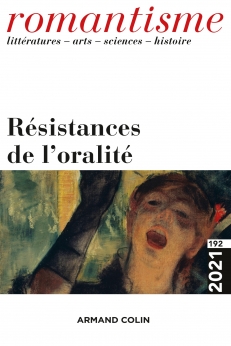
ROMANTISME N°192 (2/2021)
Pour acheter ce numéro, contactez-nous
Recevez les numéros de l'année en cours et accédez à l'intégralité des articles en ligne.
Alors qu’au début du XIXe siècle, l’intérêt grandit pour les cultures des campagnes, la représentation écrite des parlers paysans se heurte encore à des codes littéraires qui tendent à la dévaloriser ou à l’idéaliser et empêchent de figurer de manière satisfaisante le monde rural. Cet article propose de se pencher sur les stratégies narratives développées par George Sand dans ses romans champêtres pour contrer ce double écueil, linguistique et anthropologique. Sand y cherche constamment à mettre en valeur la vocalité des parlers paysans et à souligner leur ancrage dans des cultures spécifiques dont la richesse excède de loin le traditionnel clivage entre oral et écrit. À terme, c’est à un projet politique de réconciliation démocratique auquel oeuvrent les romans champêtres, en s’inscrivant dans une problématique mêlant ethnolinguistique et anthropologie pour mieux réviser les grands partages littéraires, culturels et symboliques.
Whereas at the beginning of the 19th century interest in rural culture is increasing, the written representation of rural speech forms is still confronted with literary codes that tend to either debase or idealise them, and inhibit the satisfactory figuration of the rural world. This paper focuses on the narrative strategies developed by George Sand in her novels of country life in order to counter both the anthropological and the linguistic barrier to representation. Sand is constantly trying to highlight the vocal characteristics of peasant speech and to point out their origins in specific cultures whose wealth far exceeds the traditional divide between oral and written. Ultimately, these novels aim at a political project of reconciliation, using an ethnolinguistic and anthropological framework to better put in question major literary, cultural and symbolic divisions.

